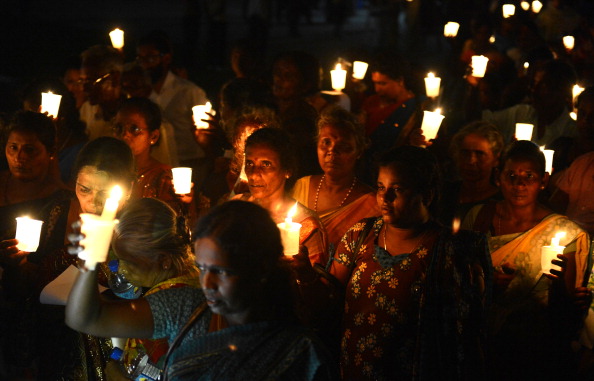
Activists hold lighted candles during a vigil on International Day of the Disappeared in Sri Lanka, where some 12,000 complaints of enforced disappearances have been submitted to the U.N. since the 1980s (Photo Credit: Lakruwan Wanniarachchi/AFP/Getty Images).
Every year in dozens of countries around the world, thousands of men, women and children are detained by state authorities for no reason, never to be seen again. They are the “disappeared.” In 2012 alone, Amnesty International documented such cases in 31 countries.
Here are five facts you should know on August 30, International Day of the Victims of Enforced Disappearances.
- Since the beginning of the uprising that led to armed conflict in Syria two years ago, there’s again been a dramatic increase in the authorities’ use of enforced disappearances to silence opposition and sow fear among their friends and relatives. Thousands of people have been arrested, with many held incommunicado at unknown locations at which torture and other ill-treatment are reported to be rife. This adds to the some 17,000 people, mostly Islamists, who were disappeared in the late 1970s and early 1980s in the country.
- In Sri Lanka, some 12,000 complaints of enforced disappearances have been submitted to the U.N. since the 1980s. But the actual number is much higher, with at least 30,000 cases alleged up to 1994 and many thousands reported after that.
- In Mexico, more than 26,000 people were reported missing or disappeared between 2006 and 2012 – mainly in the context of the violence between drug cartels and security force deployments to combat organized crime. The security forces are responsible for some of these, but investigations in almost all cases are so poor that victims are rarely found and virtually no one has been held to account.
- More than a third of the countries where Amnesty International documented enforced disappearances in 2012 were in sub-Saharan Africa in: Angola, Chad, Côte d’Ivoire, Democratic Republic of the Congo, Equatorial Guinea, Eritrea, Gambia, Mali, Mauritania, Nigeria and South Sudan.
- Despite constant requests by the relatives of the missing, the U.N. Interim Administration in Kosovo (UNMIK), responsible for the investigation and prosecution of crimes under international law, failed to investigate hundreds of the enforced disappearances and abductions that took place during the 1998-89 armed conflict in Kosovo and in its aftermath.
I can't believe this is a practice enforced by the government over there. I am aware that states do a lot of dirty things to get the results they want, but I never expected them to carry on with these even after the whole world is aware of them.
They are the “disappeared.” In 2012 alone, Amnesty International documented such cases in 31 countries.
Same practice is going on in Karachi by the Government with the help of Law Enforcement Agencies, 1000's are missing, kidnaped and are getting killed extra judicially in the name of fake Law & Order situation. Kill & dump policy is becoming common in Karachi, Urdu speaking resident no mater what age, either male or female are being kidnapped/missing and later found somewhere but the road dead, their bodied are tortured. Its time to look in this mater. I agree with isabela.
Nice article and website to be the part of. i like it and is the best to explore/